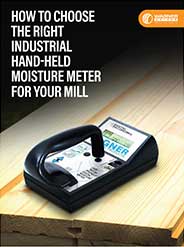Wood Species Database
If a species is not footnoted with a number (1-18), then the specific gravity for that species has not been verified by Wagner. In most cases, with unverified species, these species have the same botanical name as the verified version but just a different common name. Many species (botanical name) in the world have many different common names. The footnote descriptions are shown at the bottom of the page.*
Wood Species Types in Alphabetical Order
To obtain the most accurate moisture content measurements with your Wagner moisture meter, you must set the meter for the correct species settings value for the species you are going to measure. For our customers' convenience, we have calibrated our meter's species settings in terms of specific gravity.*
For those instances where you need to measure moisture in a wood species that is not shown in your User’s Manual, Wagner has compiled this extensive database of wood species with their associated specific gravity values.
The sources for our database include the United States Department of Agriculture, Forest Products Laboratory.
The published specific gravity values are the average for each species. There can and will be some variability of the specific gravity (density) within any species of wood, but the average specific gravity value (again, from the most valid published sources) will provide the best settings for your Wagner moisture meter.
| Common Name | Botanical Name | Specific Gravity | Verified |
|---|---|---|---|
| A Koura | Lophira alata | 0.94 | |
| Aba | Lophira alata | 0.94 | |
| Abacateiro | Hieronyma alchorneoides | 0.58 | |
AbachiSee other common name Obeche for verified SG for this same botanical name. | Triplochiton scleroxylon | 0.32 | |
| Abacu | Tieghemella heckelii | 0.6 | |
| Abako | Tieghemella heckelii | 0.6 | |
| Abaku | Tieghemella heckelii | 0.6 | |
| Abang | Chlorophora excelsa | 0.7 | |
| Abang | Chlorophora regia | 0.59 | |
Abassian BoxwoodSee other common name Box for verified SG for this same botanical name. | Buxus sempervirens | 0.83 |
Footnotes:
* Legal disclaimer:
Wagner has compiled species’ average specific gravity (SG) values (wood volume at 12% moisture content (MC) and oven-dry weight) from industry-accepted 3rd-party sources (USDA Forest Products Laboratory as an example) and provides this list for free with no implied warranty. Where an SG value listed in Wagner Meters’ manuals or website has been verified by Wagner, this is indicated as such, and not indicated as verified if a verification process has not been completed by Wagner for that species. Wagner is not responsible for any 3rd-party oversights or errors in their (the 3rd-parties) published SG values.
Where no published average SG value could be found for a species for the wood volume at 12% MC and oven-dry weight basis, Wagner has derived the proper SG value through a robust algorithm (see detailed explanation below under the heading ‘Specific Gravity (SG) Values of Wood and Their Referenced Moisture Content’).
Specific Gravity (SG) Values of Wood and Their Referenced Moisture Content
Wagner Meters’ moisture meters’ species settings are calibrated to wood samples that are at a nominal 12% moisture content (MC). It should also be recognized that the measurement accuracy of non-pin wood moisture meters is almost solely dependent on wood density; that is because wood species that have differing wood density but the same absolute amount of water will have different MC values because the definition of MC is the ratio of water weight to wood weight. Some online and other technical references that cite specific gravity (SG) values for different wood species list the SG when the wood is a different MC other than 12%. For example, some SG values listed are the values when the wood is dried all the way down to where the MC is actually zero. Other listed values are when the wood is “green” at perhaps 80% MC or even higher.
The reason that it matters what the MC was when the SG was determined is that the volume of a wood sample will shrink when it is dried down from high MC values to lower MC values. So as the volume of the wood sample shrinks, the density (SG) of the wood increases because the formula for the wood density is the weight of the wood sample divided by the volume of the wood sample, or more simply the ratio of the weight of the wood to its volume. As the weight stays the same during shrinkage, the volume decreases. Online and other references will not only provide SG values at some specific MC but also their “shrinkage ratio”. The shrinkage ratio is defined to be the percent of the volume of the wood that shrinks per decrease in MC value. For instance, one might see a 2% shrinkage ratio which means that for every 1% drop in MC the wood will shrink by 2% of its volume.
Wagner chose to calibrate its meters at a nominal 12% MC because this is close to where most wood will be in service and will be measured by our meters. Therefore we publish SG values for wood species to be used by our meters that correlate to a 12% MC value. Since online and other references publish SG values at sometimes 0% MC or “green” MC, you will often see different values online than what we publish. We correct these published values by applying correction factors based on MC at referenced SG values and shrinkage ratio published values. It should be noted that a wood sample will not begin shrinking significantly until the MC drops below fiber saturation point, which is generally between 28% and 32%, so we use 30% as the average fiber saturation point.
As an example, let’s say we have a published SG value of 0.50 referenced to 0% MC with a shrinkage ratio of 0.1% of volume per percent MC. We want to convert to an SG value referenced to 12% MC. A sample at 12 % MC will be 1.2% larger in volume (swells 12 * 0.1%). Since 0.50 equals the weight of the sample divided by volume, we now know the volume will actually be 1.2% larger, so the SG should be adjusted by a factor of 1 divided by (1 + 1.2%) or 1 divided by (1.012) = 0.50/1.012 = 0.49). So, in this specific case, the 12 % MC referenced SG value will be slightly less than the published value referenced at 0% MC.



